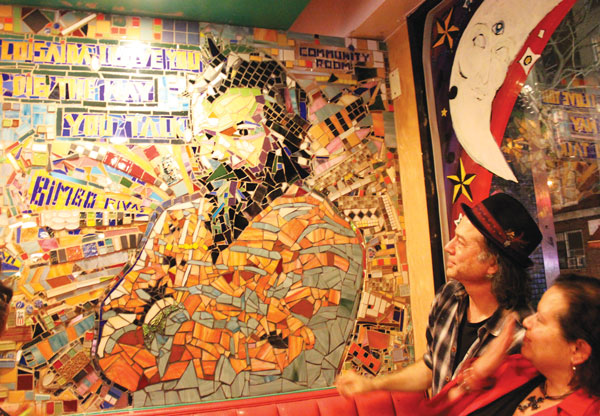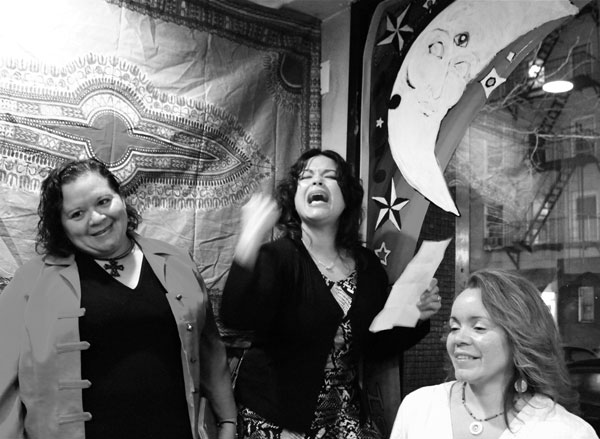 [/media-credit]
[/media-credit]
Rivas, known to all as Bimbo, was a Puerto Rican community activist, poet, playwright, actor, director and teacher, who coined the term “Loisaida” to denote Avenue C in his 1974 poem of the same name. This May will mark the 20th anniversary of his sudden death from a heart attack while teaching in a classroom in Brownsville, Brooklyn. He was 52 years old and the father of six children.
Much of the Rivas clan, including children, grandchildren, nieces and nephews and Kymberly Brown, Rivas’s partner at the time of his death, who was six weeks pregnant with his daughter, was present to share in the emotional occasion. Three of his daughters, Michelle, Sandra and Maraluna, stood before the unveiled portrait, as the latter led the crowd in an impassioned call-and-response recitation of the bilingual “Loisaida.”
Maraluna Rivas offered her gratitude to Two Boots owner Phil Hartman for “preserving my father’s image, memory and spirit,” and spoke of the love and passion her father had for the community, “for all of these blocks, from First Avenue to Avenue D, from 14th Street to Houston Street and beyond.” Avenue C between Houston and E. 14th Sts. was officially designated as “Loisaida Avenue” in 1992 with green street signs.
Michelle Rivas told The Villager what it was like when she was growing up.
“It was burnt out and a landlord-abandonment neighborhood,” she recalled. “Everything was negative. Then they [Rivas and other activists] took over the buildings, retrained gang members, who became artists and workers in the community. I used to fight with my dad, grabbing drug dealers and telling them they had till sundown to get out of our parks. He was a pioneer. When people walk around now they can feel the flavor. There was no flavor before Bimbo, Chino and Armando.”
 [/media-credit]
[/media-credit]
The former school building housing CHARAS, at 605 E. Ninth St., was sold to developer Gregg Singer at public auction in 1998. Singer evicted CHARAS three years later. The old P.S. 64 remains closed today, a vacant eyesore.
Hartman began his pizza empire, now totaling a dozen restaurants, across the street from his current location at 42 Avenue A at E. Third St.
“We started in the East Village, so we wanted the first of the 25 events to be here,” he said. “There is a lot of history with CHARAS and Bimbo, and we always wanted to do something to commemorate him. We were renovating the pizzeria anyway, so it’s kind of an unveiling of the whole store as well as the mosaic.”
Hartman has several mosaics in his restaurants by Pinto as the main artist, Garcia told The Villager in a sit-down interview the next day at Cafe Pick Me Up on Avenue A.
“Phil suggested we dedicate a mosaic to Bimbo, and he built a wall just for us,” Garcia said. “He always tries to get the local community involved. He came here when not too many businesses wanted to come here.”
Garcia said that the intergenerational five-person team, including himself and Megan Kindsfather, worked on the multicolored mosaic, which is based on a black-and-white photograph of Rivas and the surrounding cityscape, taken by Lower East Side photographer Marlis Momber. The artist Rimix was brought in to design the sketch of the buildings.
“Bimbo’s spirit is in this,” Garcia said. “We’ve got great people historically on the Lower East Side, like Miriam Friedlander and Esther Rand. It’s important to identify these people, so hopefully other generations will know about them.”
Garcia worked closely with Rivas at CHARAS.
“Bimbo was a strong activist in the housing movement, as well as our engineer of electricity and carpentry and helped fix our building,” he said. “He was also our theater director. He was very down to earth and a great human being.”
In a phone interview with Guatemalan-born Pinto, who was unable to attend the festivities because of family obligations, Pinto described the 8-foot-by-7-foot mosaic, which features mirrors and stained glass. The stained glass came from leftovers donated by Patti Kelly of Kelly Glass Studio, at 368 E. Eighth St. The tiles are from sample catalogues from friends’ showrooms after the season was over, “so you are not going to find the same tiles in the composition,” Pinto said.
The mirrors are recycled from the streets of New York.
“For some people a broken mirror is bad luck. For us, it’s a blessing,” he said.
Brown, now an inner-city English teacher, had been living with Rivas for two years.
“His spirit and work he did in the community and love he had for this place and the people are still resonating in the neighborhood,” she said. “Our family has grown and continued to be poets and theater people. What was a dream is what we live every day. And the buildings are not still burning down,” she added, referring to the last lines of the poem, “Your buildings are burning up that we got to stop. Loisaida, my love, Te amo.”
On this night, it was clearly “Te amo, Bimbo.”
Pinto is gearing up for a big project at Dred Scott Bird Sanctuary Garden and Park on Grant Ave. in the South Bronx, which will take a few years and includes mosaic walls, benches and water fountains. He is appealing for donations of broken mirrors and tiles and stained glass pieces. Contact him at jucapi100@yahoo.com or Garcia at charas65@yahoo.com, and they will arrange to pick them up.

















